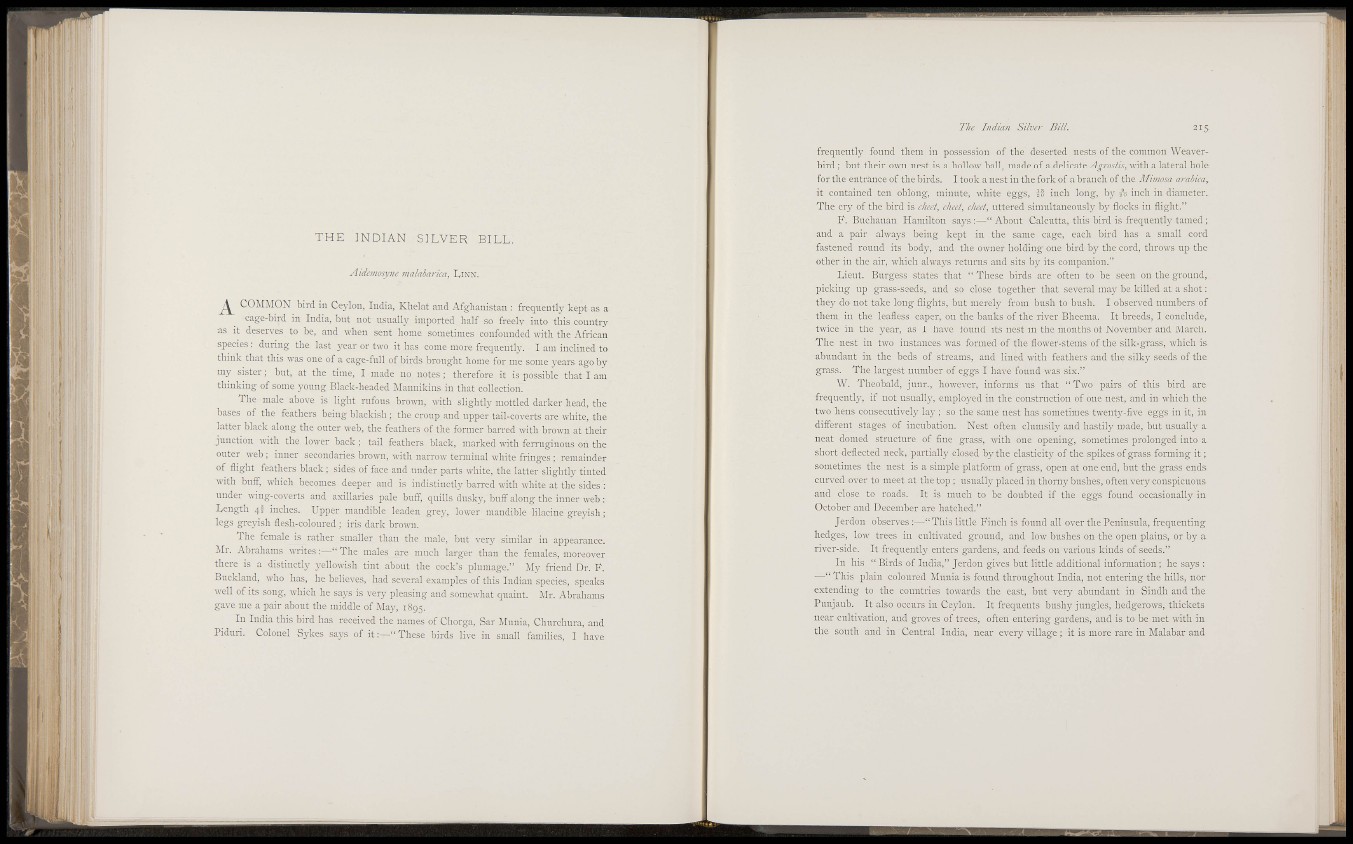
M I
/ ' l i ' l i
m
THE INDIAN SILVER BILL.
Aidf/nosyiie malabai-ica, Linn.
^ COMMON bird in Ceylon, India, Khelat and Afghanistan : frequently kept as a
cage-bird in India, but not usually imported half so freely into this country
as it deserves to be, and when sent home sometimes confounded with the African
species : during the last year or two it has come more freqnentl3-. I ^im inclined to
think that this was one of a cage-full of birds brought home for me some years ago by
my sister ; but, at the time, I made no notes ; therefore it is possible that I am
thinking of some young Black-headed Mannikins in that collection.
The male above is light rufous brown, with slightly mottled darker head, the
bases of the feathers being blackish ; the croup and upper tail-coverts are white, the
latter black along the outer web, the feathers of the former barred with b r o w at their
junction with the lower back ; tail feathers black, marked with ferruginous on the
outer web; inner secondaries brown, with narrow terminal white fringes ; remainder
of flight feathers black; sides of face and under parts white, the latter slightly tinted
^^'lth buff, which becomes deeper and is indistinctly barred with white at the sides :
under wing-coverts and axillaries pale buff, quills dusky, buff along the inner web :
Length 4I inches. Upper mandible leaden gre)-, lower mandible lilacine greyish ;
legs greyish flesh-coloured ; iris dark brown.
The female is rather smaller than the male, but very similar in appearance.
Mr. Abrahams writes:—" The males are much larger than the females, moreover
there is a distinctly yellowish tint about the cock's plumage." My friend Dr. F.
Buckland, who has, he believes, had several examples of this Indian species, speaks
of its song, which he says is very pleasing and somewhat quaint. Mr. Abrahams
_gave me a pair about the middle of May, 1895.
In India this bird has received the names of Cliorga, Sar Muuia, Churchura, and
Piduri. Colonel Sykes says of it:—" These birds live in small families, I have
The Indian Silver Bill. 315.
frequently found them in possession of the deserted nests of the common Weaverbird
; but their own nest is a hollow ball, made of a delicate AgrosHs, with a lateral hole
for the entrance of the birds. I took a nest in the fork of a branch of the Mimosa arabiea^
it contained ten oblong, minute, white eggs, JS inch long, by TO inch in diameter.
The cr}^ of the bird is eheet, ehect, eliect, uttered simultaneousl}' by flocks in flight."
P. Buchanan Hamilton says :—" About Calcutta, this bird is frequently tamed ;
and a pair alwaj'S being kept in the same cage, each bird has a small cord
fastened round its bod}-, and the owner holding one bird by the cord, throws up the
other in the air, which alwa3'S returns and sits by its companion."
Lieut. Burgess states that " These birds are often to be seen on the ground,
picking up grass-seeds, and so close together that several may be killed at a shot:
they do not take long flights, but merely from bush to bush. I observed numbers of
them in the leafless caper, on the banks of the river Bheenia. It breeds, I conclude,
twice in the year, as I have found its nest in the months of November and Iilarch.
The nest in two instances was formed of the flower-stems of the silk-grass, which is
abundant in the beds of streams, and lined -with feathers and the silky seeds of the
grass. The largest number of eggs I have found was six."
W. Tlieobald, junr., however, informs us that "Two pairs of this bird are
frequently, if not iisnall}-, eniplo3'ed in the construction of one nest, and in which the
two hens consecutively la}^ ; so the same nest has sometimes twenty-five eggs in it, in
different stages of incubation. Nest often clumsil}? and hastily made, but irsually a
neat domed structure of fine grass, with one opening, sometimes prolonged into a
short deflected neck, partially closed by the elasticity of the spikes of grass forming it ;
sometimes the nest is a simple platform of grass, open at one end, but the grass ends
curved over to meet at the top ; usually placed in thorny bushes, often very conspicuous
and close to roads. It is much to be doubted if the eggs found occasionally in
October and December are hatched."
Jerdon observes :—"This little Finch is found all over the Peninsula, frequenting
hedges, low trees in cultivated ground, and low bushes on the open plains, or by a
river-side. It frequentl3r enters gardens, and feeds on various kinds of seeds."
In his " Birds of India," Jerdon gives but little additional information ; he says :
—"This plain coloured Munia is found throughout India, not entering the hills, nor
extending to the countries towards the east, but very abundant in Sindh and the
Punjaub. It also occurs in Cejdon. It frequents bushy jungles, hedgerows, thickets
near cultivation, and groves of trees, often entering gardens, and is to be met with in
the south and in Central India, near every village ; it is more rare in Malabar and
.,1
r, -i'